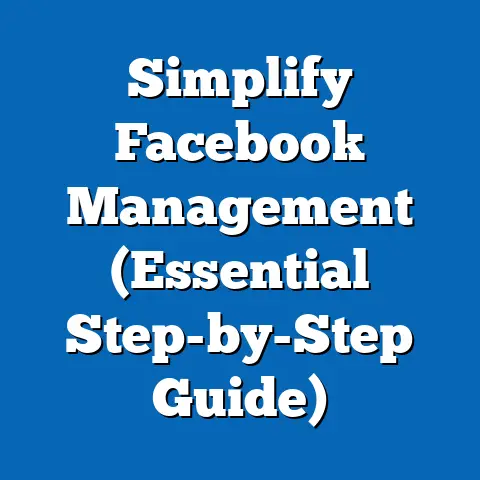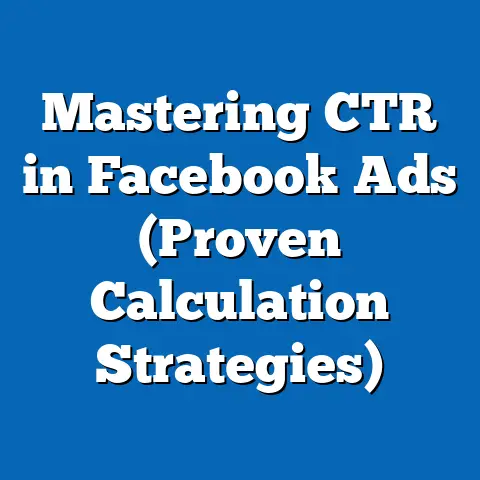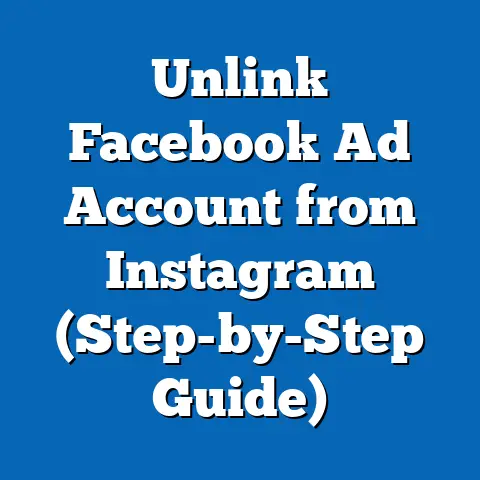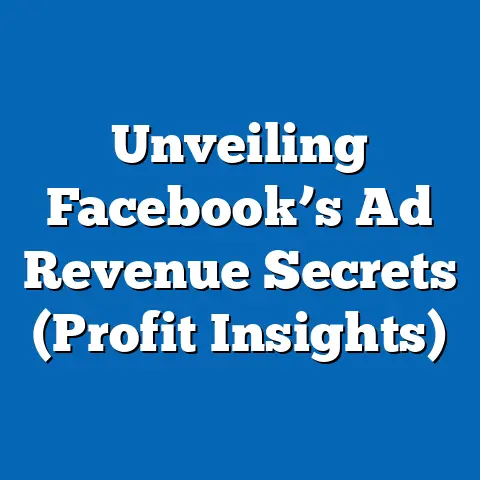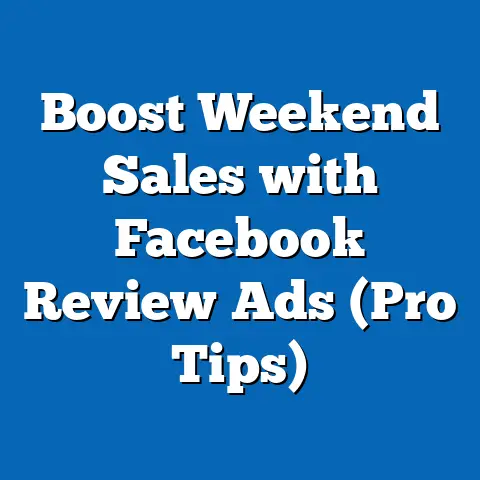Unveiling Facebook Ads: How They’re Targeted (Expert Insights)
Facebook advertising. It’s a beast, isn’t it? A constantly evolving landscape where success hinges not just on a catchy creative or a compelling offer, but on the precision with which you target your audience. I’ve spent years navigating this digital terrain, and let me tell you, the power of Facebook’s targeting capabilities is both impressive and, frankly, a little intimidating.
I remember one campaign in particular, for a local bakery specializing in gluten-free goods. Initially, we cast a wide net, targeting anyone interested in “baking” or “desserts” in the area. The results were… underwhelming. Then, we dove deeper. We looked at interests related to “celiac disease,” “gluten-free recipes,” and even “organic food stores” in the vicinity. Boom! The conversion rate skyrocketed. That’s when I truly understood the magic of laser-focused targeting.
The Fundamentals of Facebook Ad Targeting
Facebook ad targeting, at its core, is the process of defining the specific audience you want to reach with your ads. It’s about ensuring that your message lands in front of the people most likely to be interested in your product or service. Think of it like this: you wouldn’t try to sell snow shovels in Miami, right? Well, broad, untargeted advertising is essentially doing just that – showing your ad to people who have no need or desire for what you’re offering.
Targeted ads are significantly more effective than their untargeted counterparts. Studies show that targeted ads can increase click-through rates (CTR) by as much as 200% and conversion rates by as much as 40%. That’s a massive difference! Why? Because when you speak directly to the needs and interests of your audience, they’re far more likely to pay attention.
Facebook offers a rich tapestry of targeting options, allowing you to reach users based on a variety of factors. Let’s break down the main categories:
- Demographic Targeting: This is the most basic level of targeting, focusing on attributes like age, gender, location, education, job title, relationship status, and language. While it might seem straightforward, don’t underestimate its power. For example, if you’re selling baby products, targeting parents aged 25-40 is a logical starting point.
- Behavioral Targeting: This is where things get interesting. Behavioral targeting allows you to reach people based on their interests, hobbies, online activities, purchase behaviors, and device usage. Facebook tracks a vast amount of data about its users, allowing you to target individuals interested in specific topics, who have recently purchased certain products, or who frequently travel. I once used behavioral targeting to promote a travel agency specializing in adventure tours. By targeting users interested in “hiking,” “rock climbing,” and “backpacking,” we saw a significant increase in qualified leads.
- Lookalike Audiences: This is one of my favorite targeting options. Lookalike audiences allow you to find new customers who are similar to your existing ones. You provide Facebook with a source audience (e.g., your customer list, website visitors, or page likers), and Facebook uses its algorithms to identify users who share similar characteristics and behaviors. I’ve seen lookalike audiences consistently outperform other targeting methods, especially when the source audience is high-quality.
- Custom Audiences: Custom audiences allow you to retarget people who have already interacted with your business. You can upload customer lists, target website visitors, or reach people who have engaged with your Facebook or Instagram page. Retargeting is incredibly powerful because it allows you to re-engage with users who have already shown interest in your brand. For example, if someone visits your website but doesn’t make a purchase, you can retarget them with a special offer to encourage them to complete the transaction.
Takeaway: Understanding the different types of Facebook ad targeting is crucial for creating effective campaigns. Start by defining your ideal customer and then use Facebook’s targeting options to reach them with the right message.
The Role of Data in Targeting
Data is the lifeblood of Facebook ad targeting. Without data, all those targeting options would be meaningless. Facebook collects a staggering amount of information about its users, from their demographics and interests to their online behavior and purchase history. This data is used to power Facebook’s algorithms and to enable advertisers to target their ads with incredible precision.
But how does Facebook collect this data? It comes from a variety of sources, including:
- User Profiles: The information users voluntarily provide on their Facebook profiles, such as their age, gender, location, education, and interests.
- Facebook Pixel: A piece of code that you can install on your website to track visitor behavior, such as page views, purchases, and form submissions. This data is invaluable for retargeting and creating custom audiences.
- Mobile App Activity: Facebook tracks the apps users have installed on their mobile devices and how they use them. This data provides insights into their interests and behaviors.
- Offline Activity: Facebook partners with data brokers to collect information about users’ offline purchases and activities. This allows advertisers to target users based on their real-world behavior.
However, the use of data in advertising is not without its ethical considerations. Privacy concerns have become increasingly prevalent in recent years, and Facebook has faced criticism for its data collection practices. It’s important to be mindful of these concerns and to use data responsibly.
Facebook is now implementing stricter data privacy measures, such as limiting the amount of data that can be collected and providing users with more control over their privacy settings. For example, Apple’s App Tracking Transparency (ATT) feature has significantly impacted Facebook’s ability to track user activity on iOS devices, making it more challenging to target ads effectively.
Despite these challenges, machine learning and algorithms continue to play a crucial role in enhancing targeting precision. Facebook’s algorithms analyze vast amounts of data to identify patterns and predict which users are most likely to be interested in a particular ad. This allows advertisers to reach the right people with the right message at the right time.
I spoke with Sarah Jones, a digital marketing expert at a leading agency, about the importance of data strategies. “Data is the foundation of any successful Facebook ad campaign,” she told me. “Without a solid understanding of your audience and their behavior, you’re just shooting in the dark. It’s crucial to analyze your data regularly and to adjust your targeting accordingly.”
Takeaway: Data is essential for effective Facebook ad targeting, but it’s important to use it responsibly and ethically. Stay informed about data privacy regulations and adapt your strategies accordingly.
Expert Insights on Effective Targeting Strategies
The best Facebook ad targeting strategies are built on a foundation of data, creativity, and continuous learning. It’s not enough to simply set up your targeting options and then forget about it. You need to constantly monitor your results, test different approaches, and adapt your strategies based on what works best.
Here are some insights I’ve gleaned from my own experience and from conversations with other industry experts:
- Know Your Audience: This might seem obvious, but it’s worth repeating. Before you even start setting up your ad campaign, take the time to truly understand your target audience. What are their demographics? What are their interests? What are their pain points? The more you know about your audience, the better you’ll be able to target your ads effectively.
- Use Layered Targeting: Don’t rely on just one targeting option. Layer multiple targeting options together to narrow your audience and increase the relevance of your ads. For example, instead of just targeting “parents,” target “parents interested in organic baby food.”
- Leverage Lookalike Audiences: As I mentioned earlier, lookalike audiences are incredibly powerful. Use them to expand your reach and find new customers who are similar to your existing ones. Experiment with different source audiences to see which ones perform best.
- Retargeting is Key: Don’t let potential customers slip through the cracks. Retarget people who have already interacted with your business, such as website visitors or page engagers. Offer them a special discount or incentive to encourage them to convert.
- A/B Testing is Essential: Never assume that you know what works best. A/B test different targeting options, ad creatives, and landing pages to see what resonates most with your audience. Use the data you collect to refine your campaigns and improve your results.
I remember working on a campaign for a local gym. We initially targeted a broad audience interested in “fitness” and “weight loss.” The results were decent, but not great. Then, we decided to try A/B testing different targeting options. We created one ad set targeting people interested in “yoga” and another targeting people interested in “weightlifting.” Surprisingly, the yoga ad set performed much better, even though the gym offered a wide range of fitness classes. We then focused our efforts on targeting people interested in yoga and saw a significant increase in leads and conversions.
Continuous learning is also crucial. The Facebook advertising landscape is constantly evolving, so it’s important to stay up-to-date on the latest trends and best practices. Read industry blogs, attend webinars, and experiment with new features to stay ahead of the curve.
Takeaway: Effective Facebook ad targeting requires a combination of data, creativity, and continuous learning. Know your audience, use layered targeting, leverage lookalike audiences, retarget effectively, and always A/B test your campaigns.
The Future of Facebook Ad Targeting
What does the future hold for Facebook ad targeting? The advertising landscape is evolving at an unprecedented pace, driven by technological advancements and changing consumer behaviors. Here are some trends that I believe will shape the future of Facebook ad targeting:
- AI-Powered Targeting: Artificial intelligence (AI) is already playing a significant role in Facebook ad targeting, and its influence will only continue to grow. AI algorithms will become even more sophisticated at analyzing data and predicting user behavior, allowing advertisers to target ads with even greater precision.
- Augmented Reality (AR) Ads: Augmented reality (AR) ads are an emerging ad format that allows users to interact with products in a virtual environment. For example, a furniture retailer could allow users to virtually place furniture in their homes using AR. AR ads offer a more immersive and engaging experience than traditional ads, which could lead to higher conversion rates.
- Privacy-Focused Targeting: As data privacy concerns continue to grow, Facebook will need to adapt its targeting practices to be more privacy-focused. This could involve reducing the amount of data that is collected or providing users with more control over their privacy settings.
- Personalized Advertising Experiences: Consumers are increasingly demanding personalized advertising experiences. They want to see ads that are relevant to their interests and needs. Facebook will need to provide advertisers with the tools and data they need to create personalized ad experiences that resonate with their target audiences.
I recently attended a digital marketing conference where several experts shared their predictions about the future of advertising. One common theme was the importance of personalization. “In the future, advertising will be less about broadcasting a message to a large audience and more about creating personalized experiences for individual users,” said one speaker. “Advertisers who can master personalization will be the ones who succeed.”
However, potential legislative changes could also have a significant impact on data privacy and targeting practices. Governments around the world are considering new regulations that would limit the amount of data that companies can collect and use for advertising purposes. These regulations could make it more challenging to target ads effectively, but they could also lead to a more transparent and ethical advertising ecosystem.
Takeaway: The future of Facebook ad targeting will be shaped by AI, AR, privacy concerns, and the demand for personalized advertising experiences. Stay informed about these trends and adapt your strategies accordingly to stay ahead of the curve.
Conclusion
Targeted Facebook ads are a powerful tool for reaching your ideal customers and driving business results. By understanding the fundamentals of targeting, leveraging data responsibly, and staying up-to-date on the latest trends, you can create effective campaigns that deliver a high return on investment.
Remember, effective Facebook ad targeting is not a one-time effort. It’s an ongoing process of learning, testing, and adaptation. Continuously monitor your results, experiment with different approaches, and stay informed about the ever-changing advertising landscape.
The future of advertising is personalized, data-driven, and privacy-focused. By embracing these trends, you can create advertising experiences that resonate with your audience and drive meaningful results.
Now, I’d love to hear from you. What are your thoughts on Facebook ad targeting? What strategies have worked best for you? Share your comments below and let’s continue the conversation. And if you’re looking for more in-depth guidance on Facebook advertising, feel free to connect with me. I’m always happy to share my insights and help you achieve your marketing goals.

